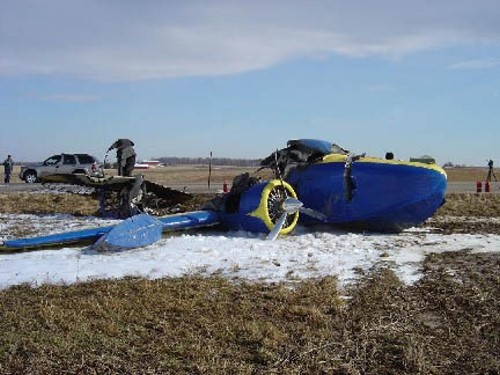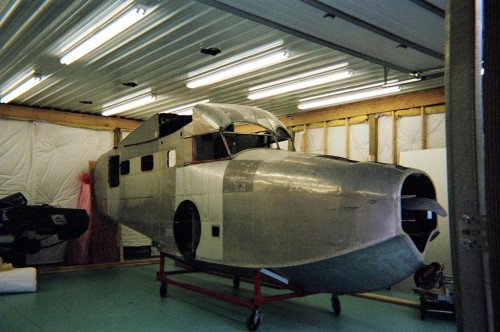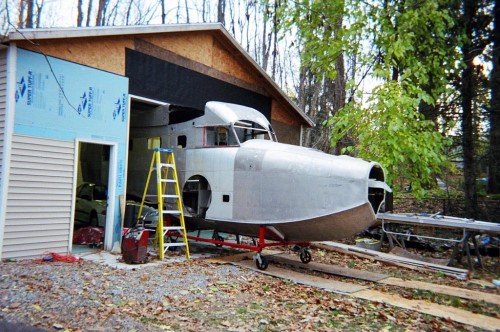The Goose
N327 C/N 1051
On September 29th 1958 The Peruvian Air Force sold two of their Grumman Gooses to Elwood R. Alexander. They were designated as 323 and 324 in the Peruvian Air Force. The Grumman construction numbers were 1051 and 1053. They were then given U.S. registration numbers of N327 and N328. Mr. Alexander purchased them for Avalon Air Transport in Long Beach, California. He paid Peru $8600 for each plane. He sold them to Avalon Air on October 8th 1958 for the same amount. This information is about N327.
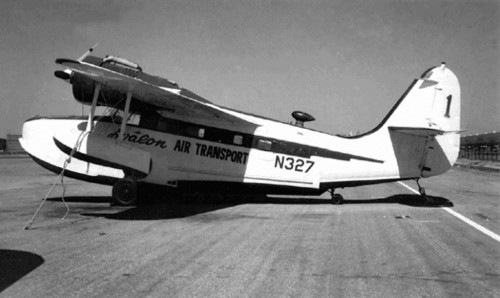
The aircraft was modified from a military model to civilian use by February 1959, and was placed into service. Seven seats were installed, spray rails were installed, both engines and props were changed, the main step extension was installed, the aircraft was painted, and a new weight and balance was completed. The left windshield was also replaced, and new floorboards were installed. It started its civilian life with 1816 hours total time.
In June of 1960 327 had new Hartzell props installed dual Marquette windshield wipers, an ARC 15C Omni system, and a new weight and balance was completed. It now has 2679 hours total time.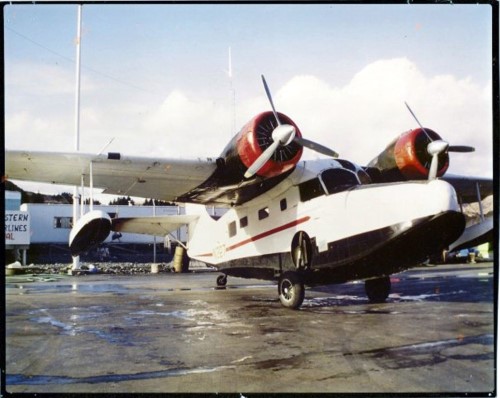
On June 11th 1970 an aircraft accident notice was filed with the FAA indicating the plane had been destroyed.
Avalon Air Transport sold the plane on May 10th 1972 to Golden West Airlines in Newport Beach, California. Golden West sells it 5 days later to Carrier Aircraft in Long Beach, California. Four days after that, May 19th 1972, it was sold to Wilton R. Probert for $550.00. On May 24th Probert sells the plane to K.C. Aircraft Sheetmetal in Long Beach for $500.00 and other considerations. The man that owns K.C. Sheetmetal owns Avalon Air that owned 327 when it was in an accident. It’s confusing to say the least.
Finally on May 25th 1974, after a complete rebuild that took 4 years to complete, it was sold to Southeast Skyways, Inc. In Juneau, Alaska.
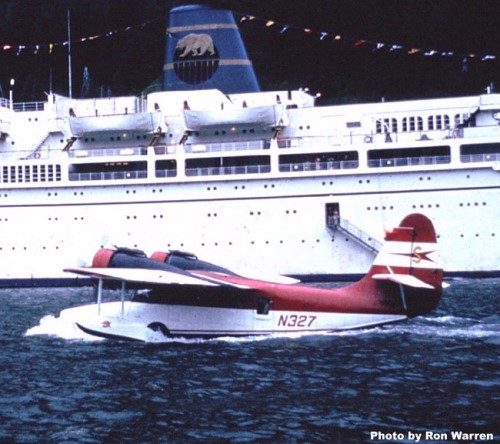
In September of 1977 327 suffered some right wing damage. The right hand wing tip was replaced with a unit furnished by Dean Franklin Ent. The struts and float wires were replaced along with the bottom wing skins between station 256 to 271, and between station 166 to 211 between the aileron spar and aft main spar.
On June 15th 1979 Southeast Skyways sells the plane to Charles F. Willis Co., Inc. No price was disclosed. Five days later on June 20th, it was sold to Robert L. Hall, owner of Kodiak Western Alaska Airlines, Inc. in Kodiak, Alaska. He also purchased goose N3282 C/N 1110 which Southeast Skyways also owned. The purchase was guaranteed by a security agreement with Wards Cove Packing Company, Inc.
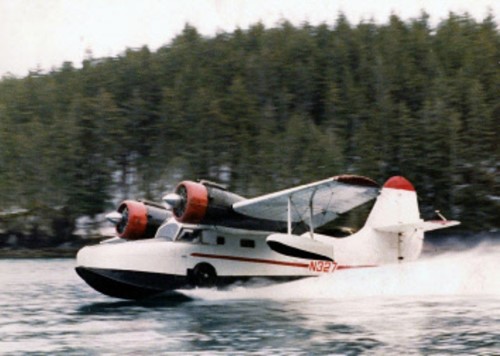
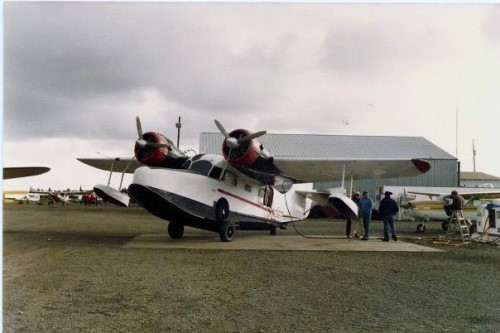
After a couple of years of operation, Kodiak Western Alaska Airlines closes for business. Robert Hall keeps N327 and moves to Washington. In June of 1981 he has the right generator replaced with a Jasco 50 amp alternator.
Exact details of what happened next are unclear, but, we know Mr. Hall leased the goose for the T.V. production “Tales of the Gold Monkey”.
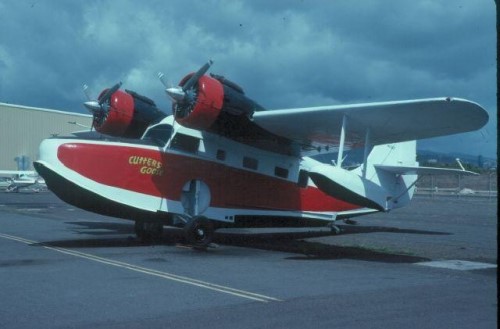
He flew as the pilot of the plane in some segments. The plane originally scheduled to be used was N2845D, but due to pilot mismanagement of the fuel system it was ditched at sea on its way down from Alaska. The Coast Guard rescued the pilot and another person just before the plane sank. The story of that is in another section on this website.
After the T.V. show Tales of the Gold Monkey ended, Bob had the goose completely gone through, 24 pages of repairs were completed over a period from July 19th 1983 through April 27th 1985. That work was completed by Aeroservice in Arlington, Washington by Fred Giles.
On September 14th 1988 Robert L. Hall sold the plane to Classic Restorations in Delaware. In March of 1990 Both generators were removed and a new alternator system was installed with alternators on both engines, a Jasco Alternator system 7555-1.
March 18th 1994 N327 was sold to James W. Chrysler in Seattle, Washington for about $280,000.
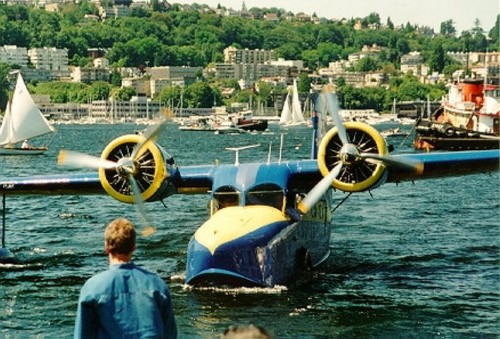
On July 22nd 1994 while practicing landings at Bremerton the pilot stated that while rolling out after landing, while at about 20 mph in a three-point attitude, he experienced a loss of directional control to the left, which he corrected with right rudder, right brake and left engine. He stated that he overcorrected, which resulted in a turn to the right. The damage included left landing gear collapse, left wing tip and spar damage, keel damage, and structural damage around the left main landing gear.
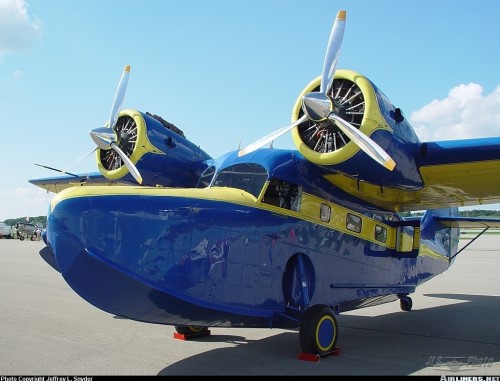
On August 19th 1996 the alternators were replaced again with the same kind that were removed.
James Chrysler sells the Plane to North Coast Aero, Cliff Larrance, in Port Townsend, Washington on January 14th 1997. No repair documents were submitted to the FAA.
Cliff Larrance then sells it to Thomas Mcdonald in New Jersey on August 19th 1998.
In May of 2000 Mcdonald sells the plane to Killa Katcha, Inc. in West Bloomfield, Michigan for about $230,000.
On July 23rd 2004 Killa Katcha, Inc. sells the plane to Jetcraft Corporation.
To modernize the brake system they installed master cylinders with ones that are used in a North American T-28. That was in November of 2004. In December of 2004 a Garmin GNS 430 Com/Nav/GPS was installed along with a lot of state of the art radio equipment.
On February 5th 2005 N327 suffered a catastrophic accident. The details are below:
IAD05LA038
On February 15, 2005, at 0942 eastern standard time, a Grumman G-21A, N327, was destroyed during a forced landing and post-crash fire near Penn Yan Airport (PEO), Penn Yan, New York. The certificated flight instructor and the private pilot receiving instruction received minor injuries. Visual meteorological conditions prevailed, and no flight plan was filed for the local instructional flight, which was conducted under 14 CFR Part 91.
According to written statements, and during telephone interviews, the flight instructor and the pilot stated that the purpose of the flight was for the flight instructor to provide multiengine airplane training to his brother, a single engine airplane-rated private pilot.
The flight instructor and the pilot met at the airport to perform a preflight inspection of the airplane, and verified that it contained 220 gallons of fuel. The pilot reported that he started the engines and allowed them to warm up, then conducted a run-up check of both engines.
The takeoff from runway 19 proceeded normally, and the pilot retracted the landing gear as he started a left turn to the crosswind leg of the traffic pattern, at an altitude about 600 feet above ground level (agl). The flight instructor then retarded the right throttle in order to simulate a failure of the right engine. The pilot performed the procedures for an in-flight engine failure, while the flight instructor guarded the engine controls.
The flight instructor looked out the right window to check for traffic and heard the pilot state, "I am at blue line but losing altitude." The pilot continued to turn the airplane left, as the flight instructor continued to scan for traffic and moved the right throttle forward to about the "half throttle" position. The flight instructor noted that the airplane was at or slightly above best single engine rate of climb speed (blue line speed), and that the airplane was descending rapidly through 400 feet agl.
The flight instructor remembered saying something to the pilot very loudly, but could not recall what he said due to the noise level in the cockpit. He also stated that he did not remember, "feeling, seeing, or hearing" the power return to the right engine. When asked, the pilot could not recall if he had adjusted either of the throttle controls after the initial application of power for takeoff. In addition, the flight instructor could not recall if the pilot had increased power on the left engine at any time during the accident sequence
The flight instructor recalled that the airplane flared before touchdown, but could not remember if he or the pilot was manipulating the flight controls at the time.
The airplane impacted the ground, caught fire, and spun 180 degrees before coming to rest. The flight instructor exited the airplane through the cabin door and the pilot exited through the left cockpit window.
In a written statement and during a telephone interview, a witness traveling northbound on the highway adjacent to the crash site stated that he saw a twin-engine seaplane flying very low and heading in an easterly direction. He saw the airplane make a "hard left turn" about 50 feet prior to reaching the roadway that he was traveling on. The left wing of the airplane impacted the ground, followed by the fuselage. Immediately upon impacting the ground, the airplane caught fire. When asked, the witness described the sound of the airplane's engines as "full loud" and "deafening."
The accident airplane was a 1939 Grumman G-21A "Goose." It had accrued 8,821 total flight hours at the time of the last annual inspection. Both engines had accumulated 80 total flight hours since the last major overhaul.
The flight instructor held an airline transport pilot certificate with ratings for airplane multiengine land and rotorcraft helicopter. He also held commercial pilot certificate with ratings for airplane multiengine sea, and airplane single engine land and sea. He held a flight instructor certificate with ratings for airplane single and multiengine, and rotorcraft helicopter. At the time of the accident, he reported 17,573 total hours of flight experience, and 46 hours of flight experience in the accident airplane make and model. He also reported that he possessed 30 hours of dual instruction given in the accident airplane make and model.
The pilot held a private pilot certificate with ratings for airplane single engine land and sea, and instrument airplane. At the time of the accident, he reported 1,834 hours of total flight experience, and 24 hours of flight experience in the accident airplane make and model.
Examination of the wreckage was conducted at the scene by Federal Aviation Administration (FAA) inspectors. Photographs of the airplane's throttle quadrant revealed that the right throttle and mixture controls were in the full forward position, the left mixture control was in an aft position, near the rear stop of the quadrant, and the left throttle control was in about the 1/3 throttle open position. The photographs also revealed that the mixture controls used a notching latch-type design that locked the mixture controls in a fixed position.
No published performance data was available for the airplane, and according to the flight instructor, much of what he knew about the performance of the airplane he learned from previous flights.
The weather reported at Penn Yan Airport, at 0946, included winds from 210 degrees at 13 knots, gusting to 18 knots, 10 statute miles visibility, scattered clouds at 2,300 feet, temperature 41 degrees Fahrenheit, dew point 34 degrees Fahrenheit, and an altimeter setting of 30.01 inches of mercury.
On the 28th of February, Jetcraft sold the remains of the plane to Samuel P Daminco in Pittsford, New York. He is restoring it as far as I know.
